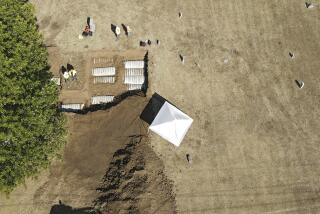Remains of U.S. Serviceman Identified
- Share via
WASHINGTON — Using forensic sleuthing involving dental remains and a chest X-ray, the Defense Department has identified the remains of an American serviceman killed in 1950 during the Korean War and buried as an “unknown” serviceman, the Pentagon said Wednesday.
The remains of Pfc. Ronald Lilledahl of Minneapolis, which had been buried in Honolulu at the National Memorial Cemetery of the Pacific, better known as “the Punchbowl,” were returned to his family, the Pentagon said in a statement.
His identical twin, Donald, 73, still lives in Minneapolis and was notified along with other relatives of the positive identification. The family held a memorial service for Ronald Lilledahl in 1951 and plans a burial ceremony next month.
Lilledahl was the first “unknown” serviceman from the 1950-53 Korean War to be identified, officials said. More than 8,100 remain listed as missing in action from the war.
Lilledahl’s Marine Corps unit was surrounded by Chinese forces on the western side of the Chosin Reservoir and cut off from supporting units in a seesaw battle Nov. 28, 1950. The Pentagon said Lilledahl was believed to have been killed by enemy fire and buried in a shallow grave, but in the ensuing withdrawal, his unit was unable to retrieve all its dead.
Another brother, William, was wounded in the war but survived and is still alive.
After the armistice, North Korea returned remains believed to be those of U.S. servicemen, but the forensic technology at the time failed to make positive identifications of more than 800 servicemen, who were buried as “unknowns” at the Punchbowl, according to the Pentagon.
In 1999, an Army laboratory in Hawaii exhumed two of the Korean War’s unknown servicemen for possible identification, the Pentagon said. Over the next three years, the lab submitted samples to military DNA experts, but no usable DNA data could be extracted.
But the lab uncovered a postage stamp-sized chest X-ray in Ronald Lilledahl’s medical records, and investigators were able to detect strong similarities to his remains.
More to Read
Sign up for Essential California
The most important California stories and recommendations in your inbox every morning.
You may occasionally receive promotional content from the Los Angeles Times.










